1996 ACURA RL KA9 sensor
[x] Cancel search: sensorPage 1156 of 1954
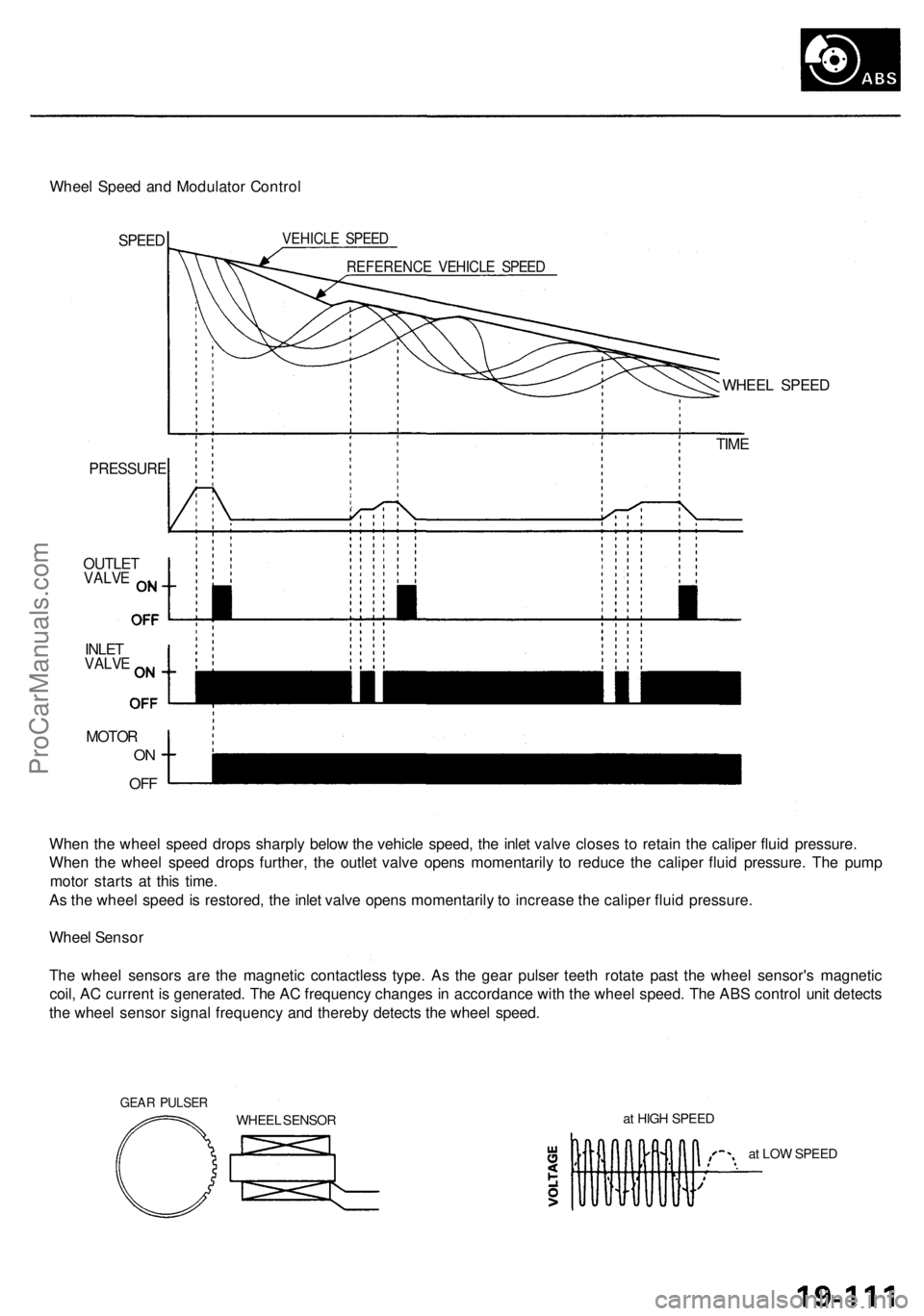
Wheel Spee d an d Modulato r Contro l
SPEED VEHICL E SPEE D
REFERENC E VEHICL E SPEE D
PRESSUR E
OUTLETVALVE
INLETVALV E
MOTO R
ON
OF F
WHEE L SPEE D
TIM E
Whe n th e whee l spee d drop s sharpl y belo w th e vehicl e speed , th e inle t valv e close s t o retai n th e calipe r flui d pressure .
Whe n th e whee l spee d drop s further , th e outle t valv e open s momentaril y t o reduc e th e calipe r flui d pressure . Th e pum p
moto r start s a t thi s time .
A s th e whee l spee d i s restored , th e inle t valv e open s momentaril y t o increas e th e calipe r flui d pressure .
Whee l Senso r
Th e whee l sensor s ar e th e magneti c contactles s type . A s th e gea r pulse r teet h rotat e pas t th e whee l sensor' s magnetic
coil , A C curren t i s generated . Th e A C frequenc y change s i n accordanc e wit h th e whee l speed . Th e AB S contro l uni t detect s
th e whee l senso r signa l frequenc y an d thereb y detect s th e whee l speed .
GEAR PULSE R
WHEEL SENSO R a
t HIG H SPEE D
at LO W SPEE D
ProCarManuals.com
Page 1169 of 1954
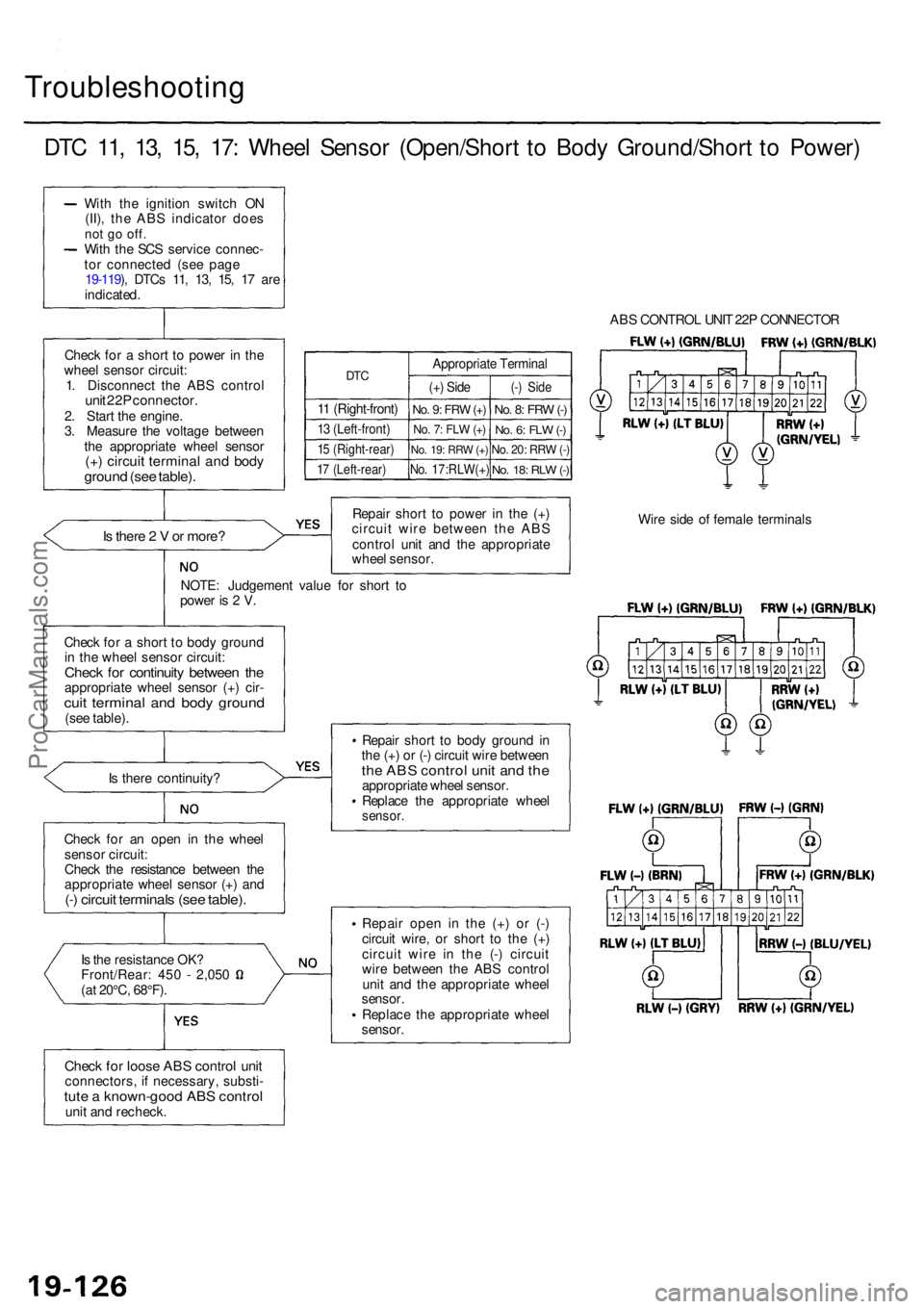
Troubleshooting
DTC 11 , 13 , 15 , 17 : Whee l Senso r (Open/Shor t t o Bod y Ground/Shor t t o Power )
With th e ignitio n switc h O N
(II) , th e AB S indicato r doe s
not g o off .With th e SC S servic e connec -
to r connecte d (se e pag e
19-119 ), DTC s 11 , 13 , 15 , 1 7 ar e
indicated .
Chec k fo r a shor t t o powe r i n th e
whee l senso r circuit :
1 . Disconnec t th e AB S contro l
unit 22 P connector .2. Star t th e engine .
3 . Measur e th e voltag e betwee n
th e appropriat e whee l senso r
(+) circui t termina l an d bod ygroun d (se e table) .
DTC
11 (Right-front )
13 (Left-front )
15 (Right-rear )
17 (Left-rear )
Appropriat e Termina l
(+) Sid e
No. 9 : FR W (+)
No . 7 : FL W (+ )
No . 19 : RR W (+ )
No . 17:RLW(+ )
(-) Sid e
No. 8 : FR W (-)
No . 6 : FL W (-)
No . 20 : RR W (-)
No . 18 : RL W (-)
Is ther e 2 V or more ?
NOTE : Judgemen t valu e fo r shor t t o
powe r i s 2 V . Repai
r shor t t o powe r i n th e (+ )
circui t wir e betwee n th e AB S
contro l uni t an d th e appropriat e
whee l sensor .
Chec k fo r a shor t t o bod y groun d
i n th e whee l senso r circuit :
Check fo r continuit y betwee n th eappropriat e whee l senso r (+ ) cir -cuit termina l an d bod y groun d(see table) .
I s ther e continuity ?
Chec k fo r a n ope n i n th e whee l
senso r circuit :
Chec k th e resistanc e betwee n th e
appropriat e whee l senso r (+ ) an d
(-) circui t terminal s (se e table) .
Is th e resistanc e OK ?Front/Rear : 45 0 - 2,05 0
(a t 20°C , 68°F) .
Check fo r loos e AB S contro l uni tconnectors , i f necessary , substi -tute a known-goo d AB S contro lunit an d recheck . Repai
r shor t t o bod y groun d in
th e (+ ) o r (- ) circui t wir e betwee n
the AB S contro l uni t an d th eappropriat e whee l sensor .
Replac e th e appropriat e whee l
sensor .
Repair ope n i n the (+) o r (- )
circui t wire , o r shor t t o th e (+ )
circui t wir e i n th e (- ) circui t
wir e betwee n th e AB S contro l
uni t an d th e appropriat e whee l
sensor .
Replac e th e appropriat e whee l
sensor . AB
S CONTRO L UNI T 22 P CONNECTO R
Wir e sid e o f femal e terminal s
ProCarManuals.com
Page 1170 of 1954
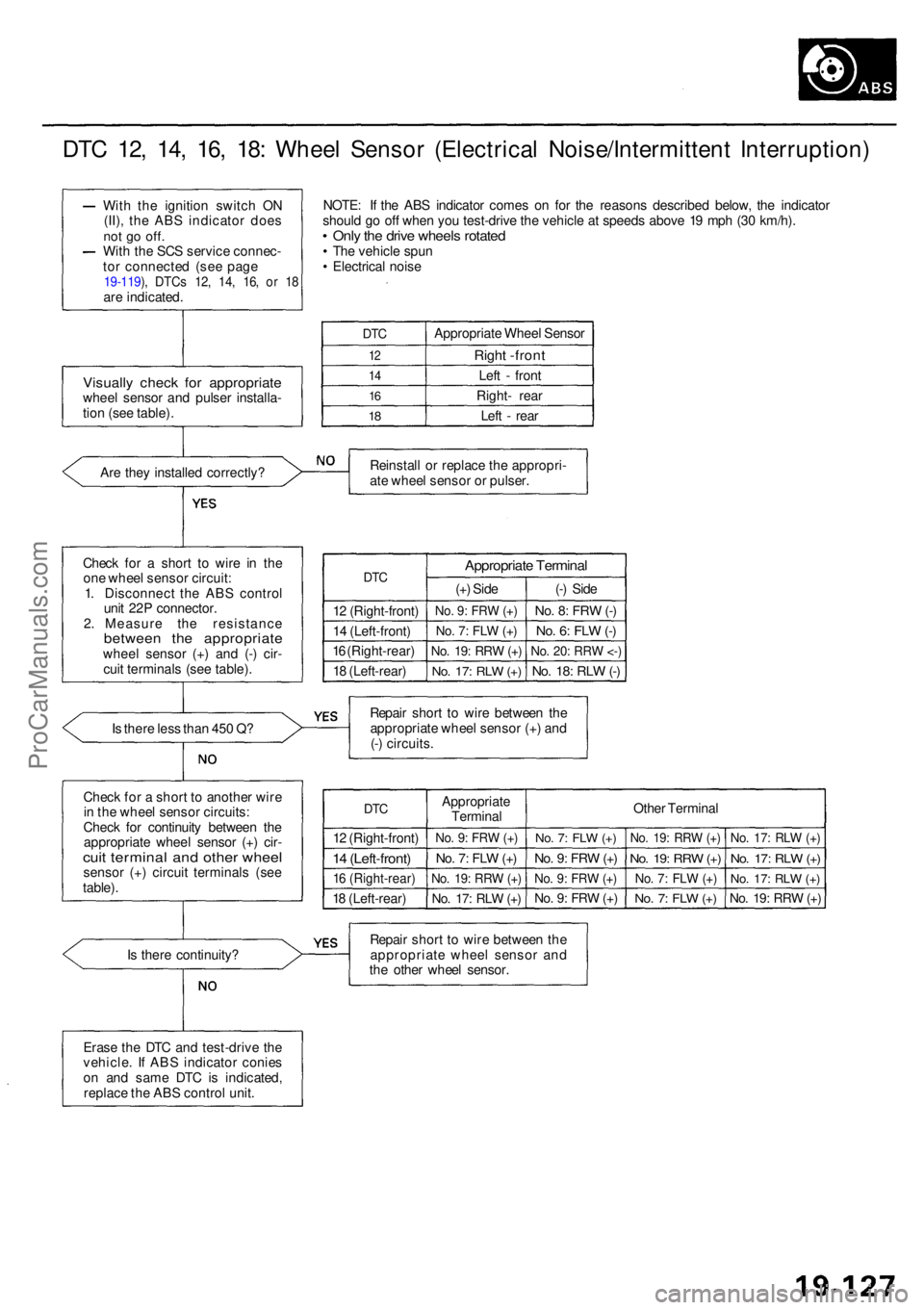
DTC 12 , 14 , 16 , 18 : Whee l Senso r (Electrica l Noise/Intermitten t Interruption )
Are the y installe d correctly ?
Chec k fo r a shor t t o wir e i n th e
on e whee l senso r circuit :
1 . Disconnec t th e AB S contro l
uni t 22 P connector .
2 . Measur e th e resistanc e
between th e appropriat ewheel senso r (+ ) an d (- ) cir -
cui t terminal s (se e table) .
I s ther e les s tha n 45 0 Q ?
Chec k fo r a shor t t o anothe r wir e
i n th e whee l senso r circuits :
Chec k fo r continuit y betwee n th e
appropriat e whee l senso r (+ ) cir -
cuit termina l an d othe r whee lsensor (+ ) circui t terminal s (se e
table) .
Is ther e continuity ? NOTE
: I f th e AB S indicato r come s o n fo r th e reason s describe d below , th e indicato r
shoul d g o of f whe n yo u test-driv e th e vehicl e a t speed s abov e 1 9 mp h (3 0 km/h) .
• Onl y th e driv e wheel s rotate d• Th e vehicl e spu n
• Electrica l nois e
DTC
12
1 4
16
18
Appropriat e Whee l Senso r
Right -fron t
Left - fron t
Right - rea r
Lef t - rea r
Reinstal l o r replac e th e appropri -
at e whee l senso r o r pulser .
DTC
12 (Right-front )
1 4 (Left-front )
1 6 (Right-rear )
1 8 (Left-rear )
Appropriat e Termina l
(+) Sid e
No. 9 : FR W (+ )
No . 7 : FL W (+ )
No . 19 : RR W (+ )
No . 17 : RL W (+ )
(-) Sid e
No. 8 : FR W (-)
No . 6 : FL W (-)
No . 20 : RR W <- )
No . 18 : RL W (-)
Repai r shor t t o wir e betwee n th e
appropriat e whee l senso r (+ ) an d
(- ) circuits .
DTC
12 (Right-front )
14 (Left-front )
16 (Right-rear )
18 (Left-rear )Appropriat
e
Termina l
No. 9 : FR W (+ )
No . 7 : FL W (+ )
No . 19 : RR W (+ )
No . 17 : RL W (+ )
Othe r Termina l
No. 7 : FL W (+ )
No . 9 : FR W (+ )
No . 9 : FR W (+ )
No . 9 : FR W (+ )
No . 19 : RR W (+ )
No . 19 : RR W (+ )
No . 7 : FL W (+ )
No . 7 : FL W (+ )
No . 17 : RL W (+ )
No . 17 : RL W (+ )
No . 17 : RL W (+ )
No . 19 : RR W (+ )
Repai r shor t t o wir e betwee n th e
appropriat e whee l senso r an d
th e othe r whee l sensor .
Wit
h th e ignitio n switc h O N
(II) , th e AB S indicato r doe s
not g o off .With th e SC S servic e connec -
to r connecte d (se e pag e
19-119 ), DTC s 12 , 14 , 16 , o r 1 8are indicated .
Visually chec k fo r appropriat ewheel senso r an d pulse r installa -
tio n (se e table) .
Eras e th e DT C an d test-driv e th e
vehicle . I f AB S indicato r conie s
o n an d sam e DT C is indicated ,
replac e th e AB S contro l unit .
ProCarManuals.com
Page 1187 of 1954
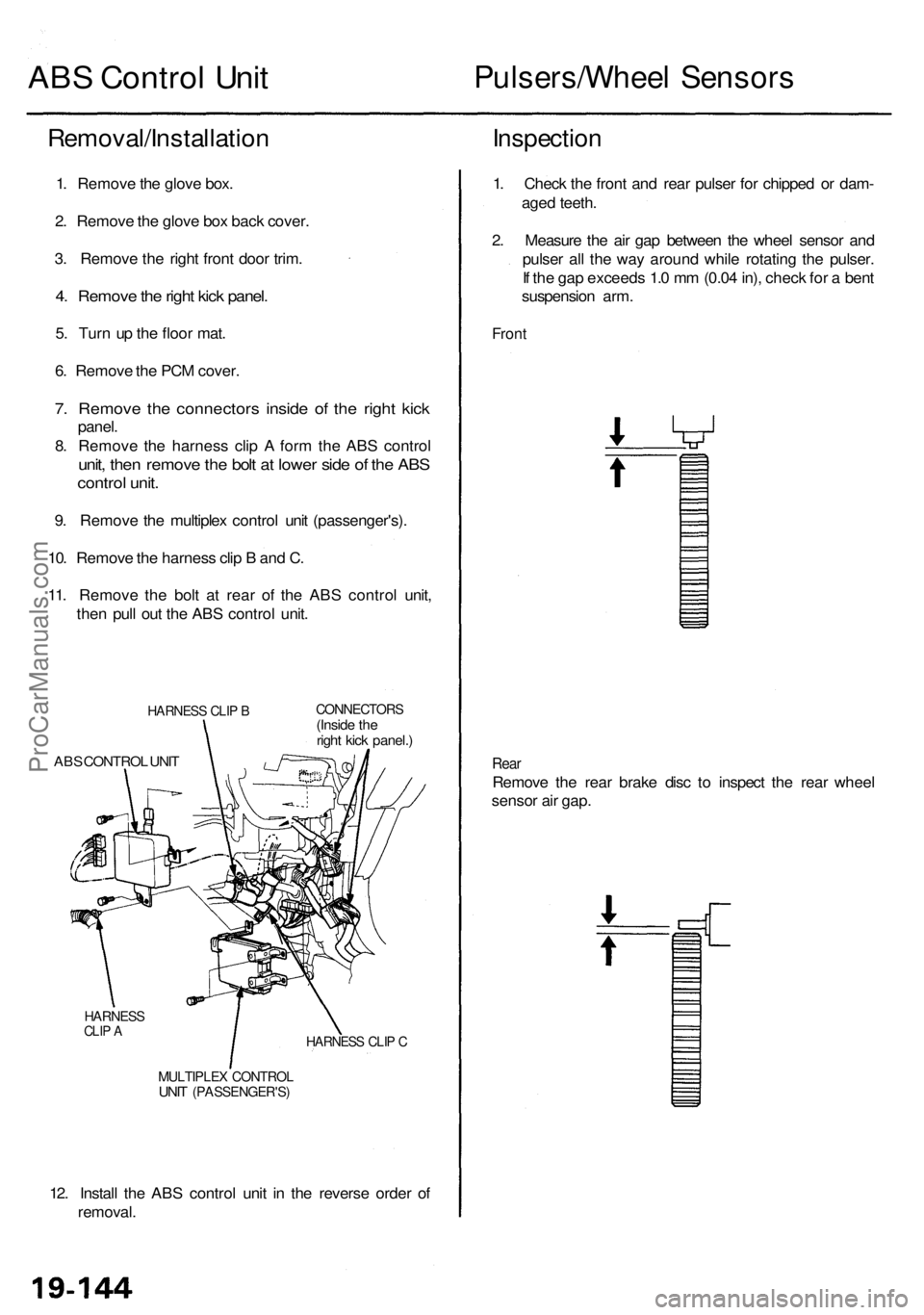
ABS Contro l Uni tPulsers/Whee l Sensor s
Removal/Installatio n
1. Remov e th e glov e box .
2 . Remov e th e glov e bo x bac k cover .
3 . Remov e th e righ t fron t doo r trim .
4. Remov e th e righ t kic k panel .
5. Tur n u p th e floo r mat .
6 . Remov e th e PC M cover .
7. Remov e th e connector s insid e o f th e righ t kic k
panel .
8 . Remov e th e harnes s cli p A for m th e AB S contro l
unit, the n remov e th e bol t a t lowe r sid e o f th e AB S
contro l unit .
9. Remov e th e multiple x contro l uni t (passenger's) .
10 . Remov e th e harnes s cli p B an d C .
11 . Remov e th e bol t a t rea r o f th e AB S contro l unit ,
the n pul l ou t th e AB S contro l unit .
HARNES S CLI P BCONNECTOR S(Inside th e
righ t kic k panel. )
AB S CONTRO L UNI T
HARNES SCLIP AHARNES S CLI P C
MULTIPLE X CONTRO LUNIT (PASSENGER'S )
12. Instal l th e AB S contro l uni t i n th e revers e orde r o f
removal .
Inspectio n
1. Chec k th e fron t an d rea r pulse r fo r chippe d o r dam -
age d teeth .
2 . Measur e th e ai r ga p betwee n th e whee l senso r an d
pulse r al l th e wa y aroun d whil e rotatin g th e pulser .
I f th e ga p exceed s 1. 0 m m (0.0 4 in) , chec k fo r a ben t
suspensio n arm .
Rear
Remov e th e rea r brak e dis c t o inspec t th e rea r whee l
senso r ai r gap .
Fron t
ProCarManuals.com
Page 1188 of 1954
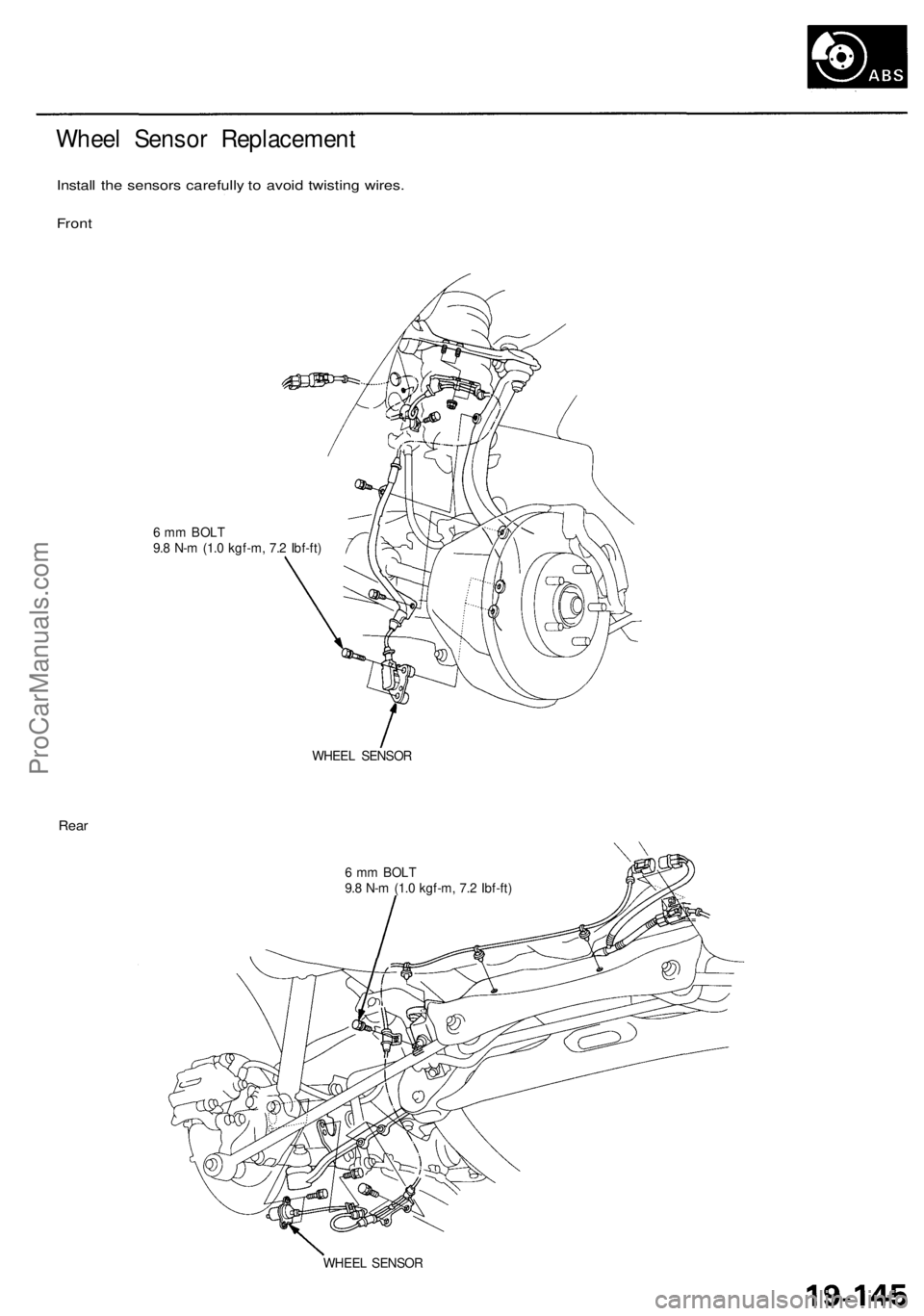
Wheel Sensor Replacement
Install the sensors carefully to avoid twisting wires.
Front
6 mm BOLT
9.8 N-m (1.0 kgf-m, 7.2 Ibf-ft)
WHEEL SENSOR
Rear
6 mm BOLT
9.8 N-m (1.0 kgf-m, 7.2 Ibf-ft)
WHEEL SENSORProCarManuals.com
Page 1190 of 1954
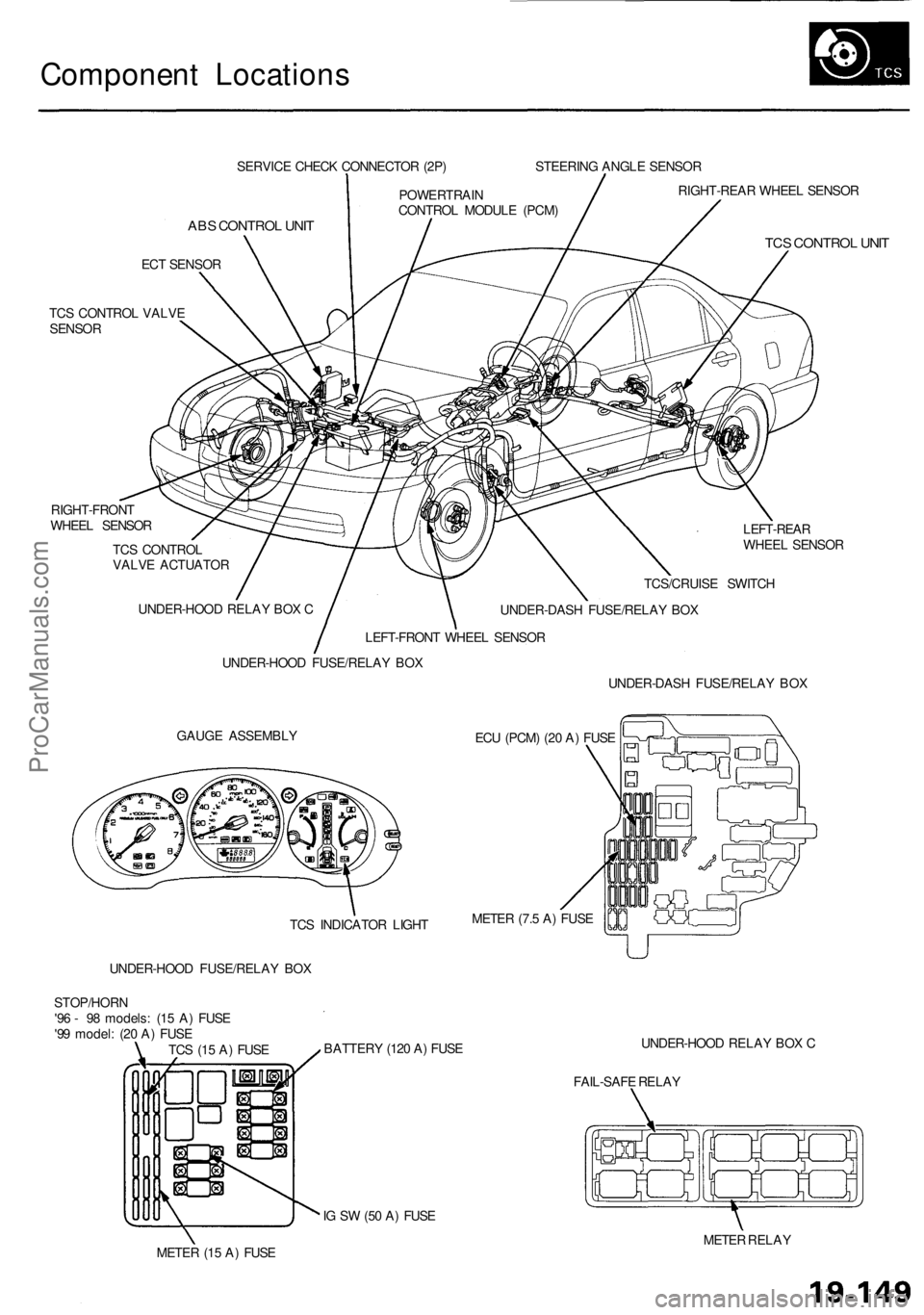
Component Locations
SERVICE CHECK CONNECTOR (2P)
ABS CONTROL UNIT
ECT SENSOR
TCS CONTROL VALVE
SENSOR
RIGHT-FRONT
WHEEL SENSOR
TCS CONTROL
VALVE ACTUATOR
LEFT-REAR
WHEEL SENSOR
GAUGE ASSEMBLY
ECU (PCM) (20 A) FUSE
UNDER-HOOD FUSE/RELAY BOX
BATTERY (120 A) FUSE
UNDER-HOOD RELAY BOX C
FAIL-SAFE RELAY
IG SW (50 A) FUSE
METER (15 A) FUSE
METER RELAY
TCS (15 A) FUSE
STOP/HORN
'96 - 98 models: (15 A) FUSE
'99 model: (20 A) FUSE
UNDER-HOOD FUSE/RELAY BOX
UNDER-HOOD RELAY BOX C
LEFT-FRONT WHEEL SENSOR
POWERTRAIN
CONTROL MODULE (PCM)
STEERING ANGLE SENSOR
RIGHT-REAR WHEEL SENSOR
TCS CONTROL UNIT
TCS/CRUISE SWITCH
UNDER-DASH FUSE/RELAY BOX
UNDER-DASH FUSE/RELAY BOX
METER (7.5 A) FUSE
TCS INDICATOR LIGHTProCarManuals.com
Page 1191 of 1954
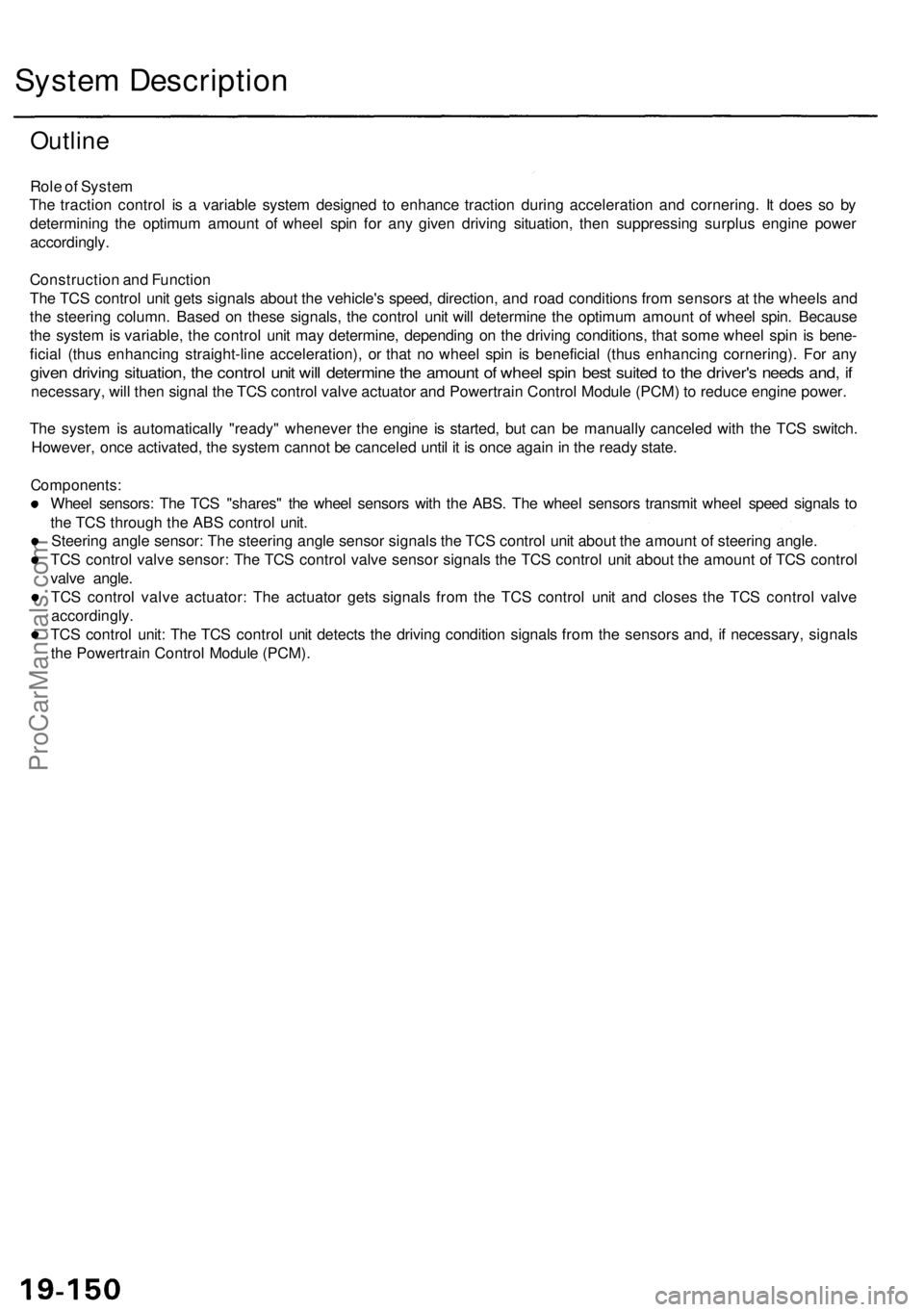
System Description
Outline
Role of System
The traction control is a variable system designed to enhance traction during acceleration and cornering. It does so by
determining the optimum amount of wheel spin for any given driving situation, then suppressing surplus engine power
accordingly.
Construction and Function
The TCS control unit gets signals about the vehicle's speed, direction, and road conditions from sensors at the wheels and
the steering column. Based on these signals, the control unit will determine the optimum amount of wheel spin. Because
the system is variable, the control unit may determine, depending on the driving conditions, that some wheel spin is bene-
ficial (thus enhancing straight-line acceleration), or that no wheel spin is beneficial (thus enhancing cornering). For any
given driving situation, the control unit will determine the amount of wheel spin best suited to the driver's needs and, if
necessary, will then signal the TCS control valve actuator and Powertrain Control Module (PCM) to reduce engine power.
The system is automatically "ready" whenever the engine is started, but can be manually canceled with the TCS switch.
However, once activated, the system cannot be canceled until it is once again in the ready state.
Components:
Wheel sensors: The TCS "shares" the wheel sensors with the ABS. The wheel sensors transmit wheel speed signals to
the TCS through the ABS control unit.
Steering angle sensor: The steering angle sensor signals the TCS control unit about the amount of steering angle.
TCS control valve sensor: The TCS control valve sensor signals the TCS control unit about the amount of TCS control
valve angle.
TCS control valve actuator: The actuator gets signals from the TCS control unit and closes the TCS control valve
accordingly.
TCS control unit: The TCS control unit detects the driving condition signals from the sensors and, if necessary, signals
the Powertrain Control Module (PCM).ProCarManuals.com
Page 1192 of 1954
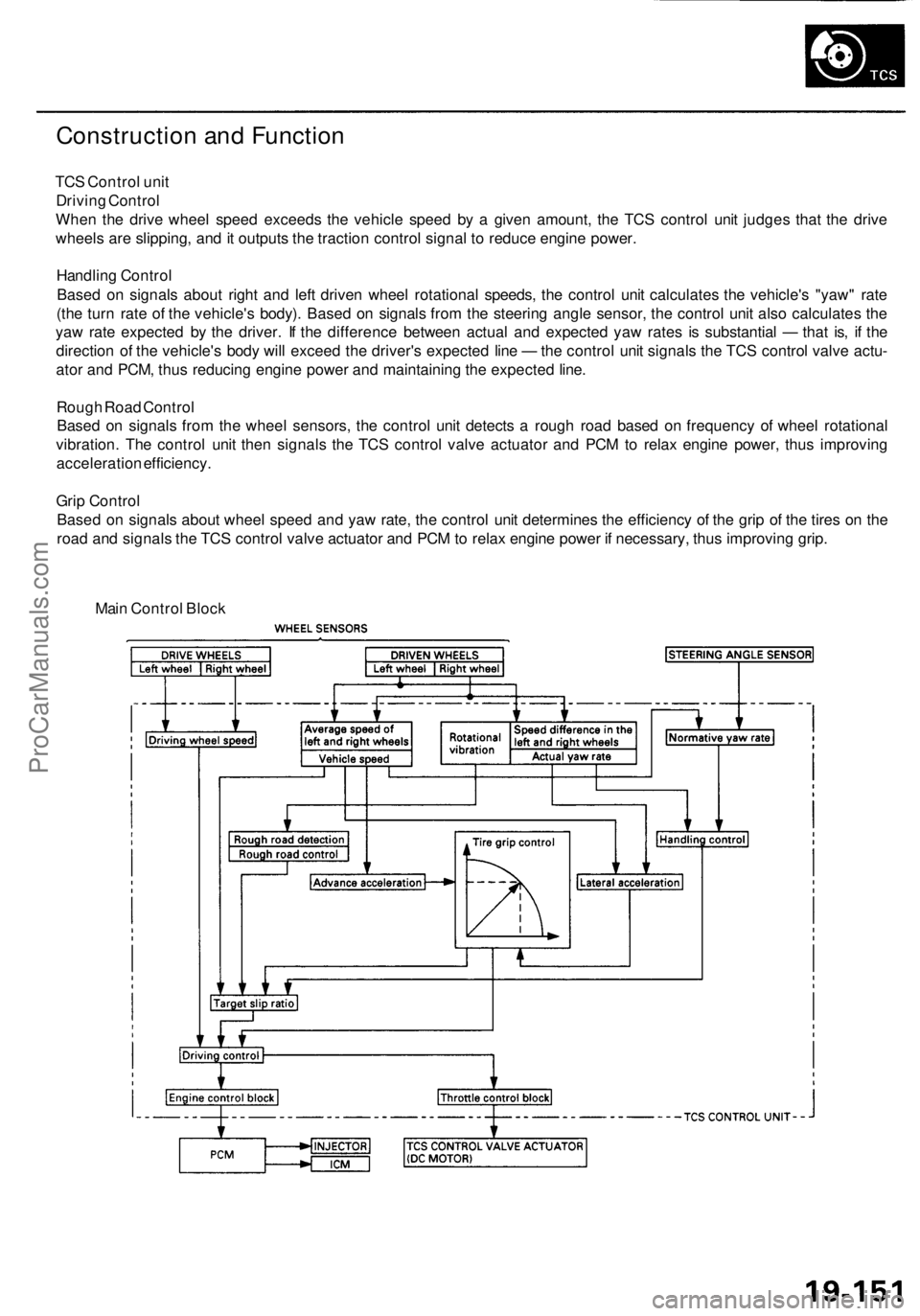
Construction and Function
TCS Control unit
Driving Control
When the drive wheel speed exceeds the vehicle speed by a given amount, the TCS control unit judges that the drive
wheels are slipping, and it outputs the traction control signal to reduce engine power.
Handling Control
Based on signals about right and left driven wheel rotational speeds, the control unit calculates the vehicle's "yaw" rate
(the turn rate of the vehicle's body). Based on signals from the steering angle sensor, the control unit also calculates the
yaw rate expected by the driver. If the difference between actual and expected yaw rates is substantial — that is, if the
direction of the vehicle's body will exceed the driver's expected line — the control unit signals the TCS control valve actu-
ator and PCM, thus reducing engine power and maintaining the expected line.
Rough Road Control
Based on signals from the wheel sensors, the control unit detects a rough road based on frequency of wheel rotational
vibration. The control unit then signals the TCS control valve actuator and PCM to relax engine power, thus improving
acceleration efficiency.
Grip Control
Based on signals about wheel speed and yaw rate, the control unit determines the efficiency of the grip of the tires on the
road and signals the TCS control valve actuator and PCM to relax engine power if necessary, thus improving grip.
Main Control BlockProCarManuals.com